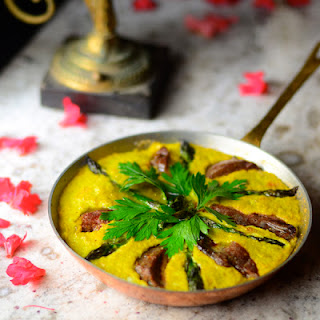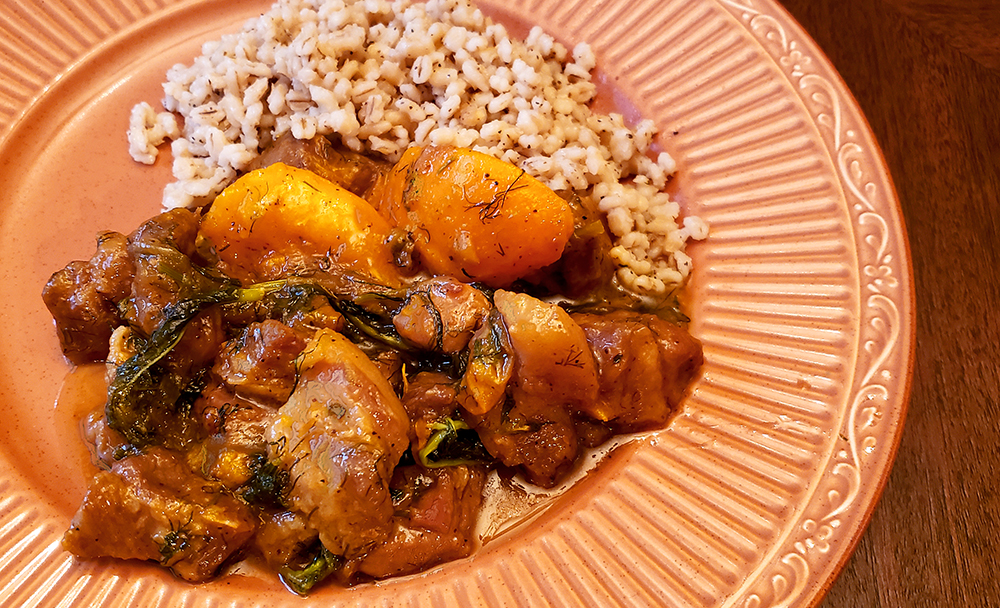I love dishes that blend meat and fruit. From Kyrgyz Beef with Apples to Bhutanese Fish with Mandarin Oranges, and Iranian Fish with Sour Cherries. As some ancient Mesopotamian archaeological assemblages of fish bones in proximity to crab apple cores suggest, humans have been pairing meat and fish with fruit for millennia. This is a Roman dish from the book credited to Apicius that blends leftover pork with one of the first to ripen fruits of the season – apricots. The savory pork coupled with the tangy but slightly sweet apricots is a great pairing that is accented by dill, oregano, and raisin wine. A bit of fresh garum or fish sauce lends an umami overtone that finishes the dish and makes it a keeper.
Original Recipe: Adicies in caccabum oleum, liquamen, vinum, concides cepam ascaloniam aridam, spatulam porcinam coctam tessellatim concides. his omnibus coctis teres piper, cuminum, mentam siccam, anethum, suffundis mel, liquamen, passum, acetum modice, ius de suo sibi, temperabis, praecoqua enucleata mittis, facies ut ferveant, donec percoquantur. tractam confringes, ex ea obligas. piper aspargis et inferes. (Apicius, 3.6)
Translation: Add into the pan: oil, fish sauce, raisin wine, sliced shallot, and cubed pork shoulder, previously cooked. When all are cooked, add in the minced pepper, cumin, mint, dill, oregano, honey, more raisin wine for broth. Add in the apricots that have been peeled, stoned, and sliced. Cook until apricots are softened. Add the tractum to bind the liquid and thicken. Finish with pepper and serve. (Apicius, 3.6)
Ingredients
- 2 lbs Pork shoulder – previously cooked
- 2 tlbs grapeseed oil
- 6 fresh, firm apricots
- 4-6 medium shallots, sliced
- 3 tlbs garum or colatura
- 1 cup raisin wine
- 2 teaspoons long pepper, ground
- ½ teaspoon cumin, ground
- 1 oz fresh mint (leaves only)
- 1 oz fresh dill sprigs, chopped
- Fresh oregano leaves or ½ teaspoon dried oregano
- 2 tbls honey
- 1-2 tbls white vinegar
- Tractum, as needed to bind liquid * (see notes)
Instructions
Cube precooked pork. One can roast or braise it the day before. If previously cooked, set aside. If pork is uncooked, heat 1 tlbs of grapeseed oil in a large pan, and sauté meat until lightly golden brown. When meat is done, remove from pan with a slotted spoon and set aside.
Wash and stone apricots, I left the skin on. Slice in quarters and set aside. Refrigerate if possible (this helps them hold up better in cooking.) Crush dried tractum to small pieces (do not crush to a powder.)
Heat (remaining) grapeseed oil in a large saucepan. Add sliced shallots and sauté until golden. Add pork back into pan and continue to cook over moderate flame for five minutes or until pork begins to darken. Now add half of the ground long pepper. Also add the cumin, mint, dill, oregano, honey and raisin wine. Cook uncovered until very hot, then lower heat to low (gas-mark 2-4) and cook covered until pork is almost done, or about 10 minutes.
Add quartered apricots and stir in well. Cook covered on low-medium for about 10 minutes or until apricots are done. Add tractum to bind liquid. Finish with remaining ground long pepper and serve.
Notes
Roman recipes almost never specify which oil is n to be used in a recipe. It could be that the use of the type of oil or fat was left up to the cook (as in Mesopotamian cooking), or like the current day, that oil use was a class-related issue because of price. The archaeological record surely indicates that olive oil was the most produced and consumed oil in ancient Rome. It is less clear about the use of other oils and the classes of people who used them. I used grapeseed oil in this recipe for its sweetness, and high flashpoint.
Buy the firmest apricots you can find and use them right away. The firmer they are, the better the flavor they will impart to the recipe, and the better they will hold up in cooking without disintegrating.
Buy real raisin wine. It is widely available in bricks-and-mortar stores, or by mail, and is much closer to the real Roman passum than raisins crushed in other types of wine. Crushing raisins into wine tastes nothing like real raisin wine. Real raisin wine is made from grapes that are dried for 4 months or more (i.e. raisins) that are then fermented and the result is VERY sweet. I used BELLINI Vin Santo raisin wine, 2009 vintage. This wine is made from white grapes hung and dried for 3-4 months before fermentation. The recipe worked well with this. If you find other modern raisin wines that are produced from grapes that are dried into raisins, please use them and let me know how they worked.
As to tractum, you can make a pan-fried flatbread (like a small chapati), let it dry completely, and crumble it into tiny bits, or you can use store-bought flatbread. Even tortillas will do. Just don’t make a powder of the dried bread. Tractum was supposed to be used in small bits that added texture as well as absorbed excess liquid.
__________
If you like this dish, please see other dishes from my Ancient Roman Cookoff, which featured the work of Charles Perry, Sally Grainger and others. There are also stand-alone recipes and cultural posts on previous pages of Silk Road Gourmet.

Photo of a Patina for Asparagus and Goose by Deana Sidney. Photo of Ancient Roman Pork and Apricots and recipe interpretation by Laura M. Kelley


Going to have to try this!
Would a mix of dibs (aka pekmez or vincotto) and wine be a good substitution for raisin wine? I am guessing it would have a high RS value and viscosity that dibs could bring to the party!
Why use a substitute when you can just buy the real thing online?
Hello Laura, we are using your book in our homeschool. I would like to speak to you about sharing these recipes on my website and YouTube channel.
Hi Hannah: I love when I hear about things like this. There are university classes that use my ancient Mesopotamian recipes from the blog, and use them to discuss women’s roles. You are welcome to use the recipes, but please give proper credit, and send a link or give me a pingback when you have content and I will link. Thanks for the interest! Laura
Món ăn ngon quá, thật sự tôi rất thèm ăn
Cảm ơn!
After a month of feeling too ill to eat, I riffled through an extensive cookbook library, and had the good fortune to choose yours. Within three days and three recipes my appetite returned. Thank you. A question: will there be a second volume?
Hi Becky: I work in the medical field and am happy that my recipes made you feel better. However, because I work in the medical field, I have been unable to make more progress on volume two since COVID-19 hit. It is still a goal of mine to publish volumes 2 & 3 – which are partially completed – but for the moment, all of my energy is going into my day job. Stay tuned, and thank you for asking. Laura